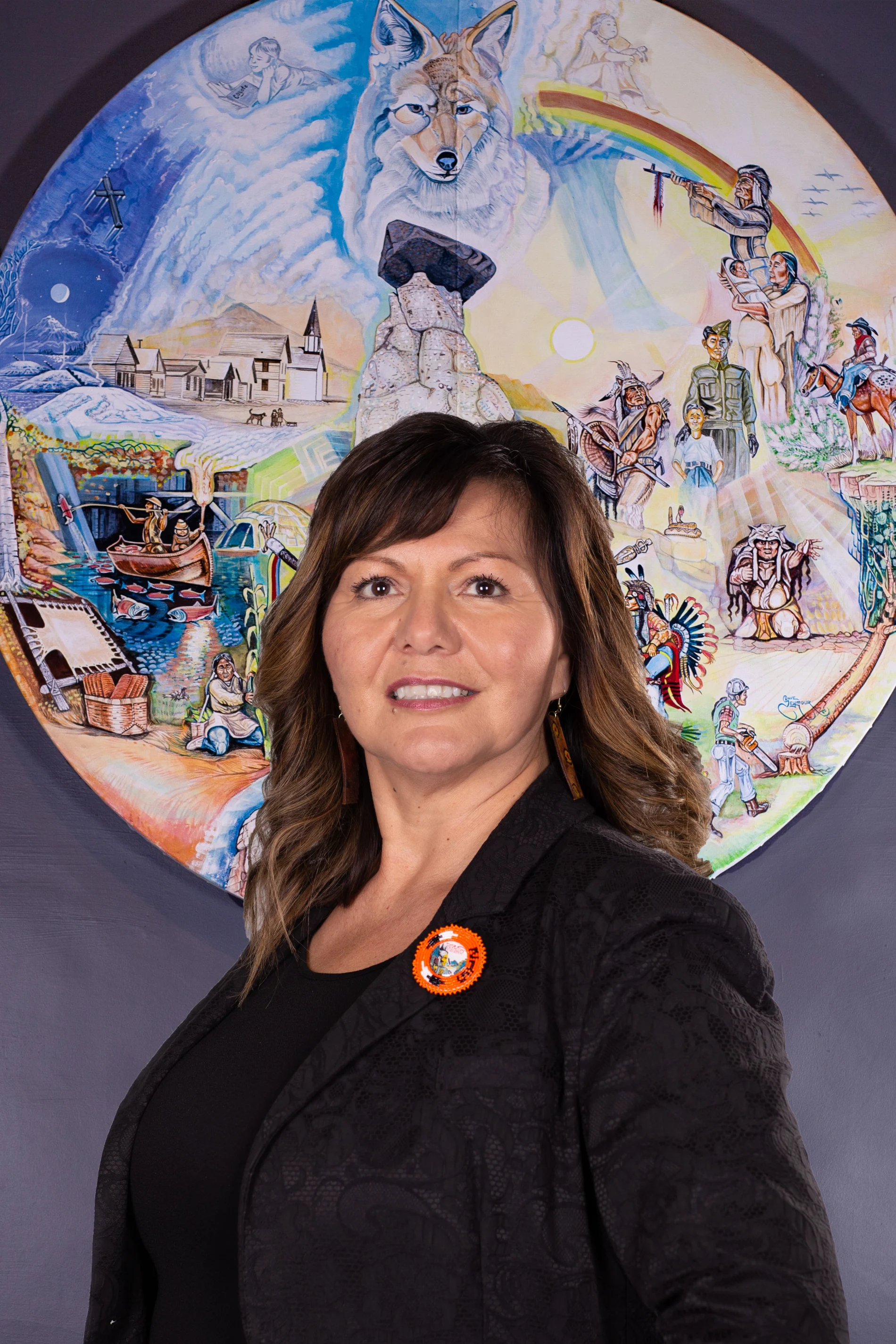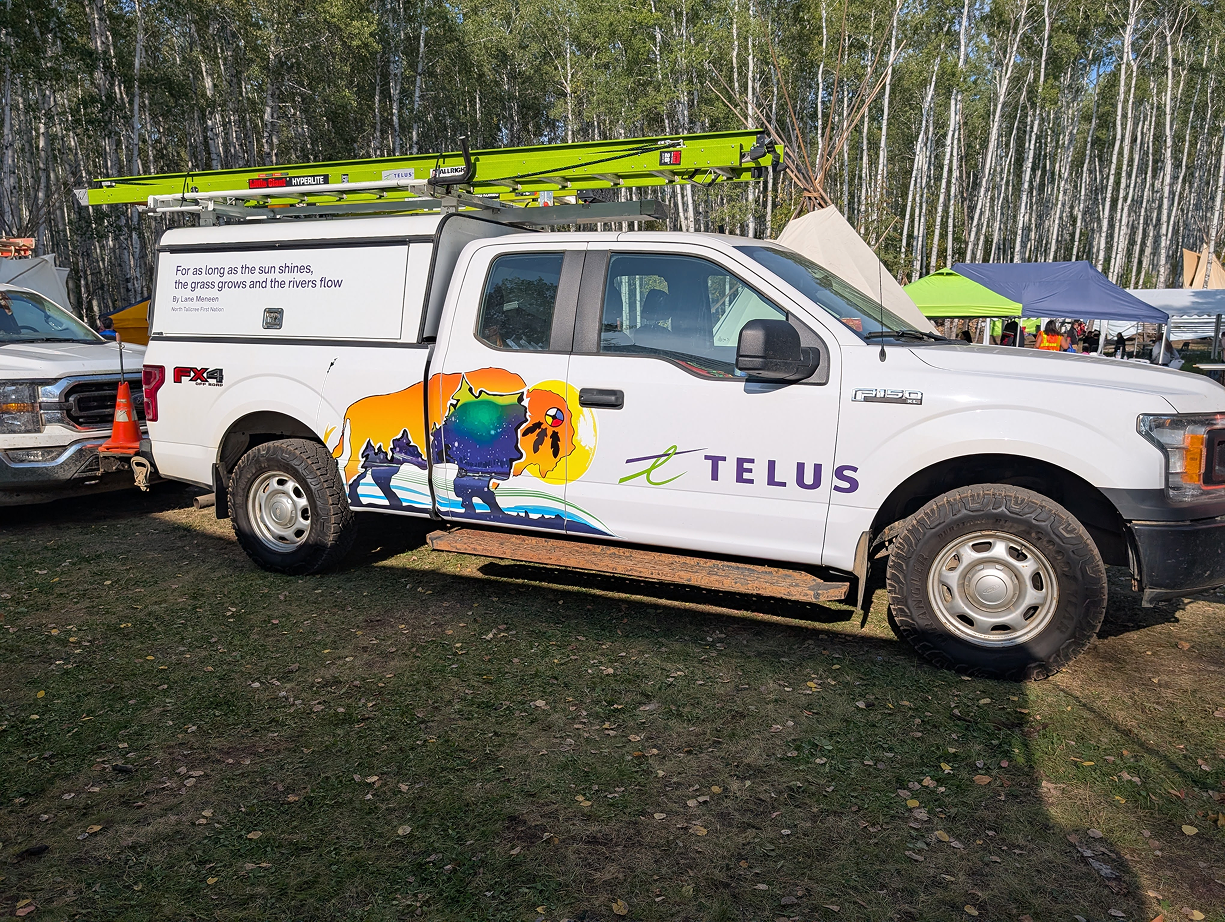
Reconciliation
What connectivity makes possible in Indigenous communities
Dec 23, 2022
(Above) In support of Reconciliation, TELUS is collaborating with Indigenous Peoples to connect their communities. CANDICE CAMILLE PHOTOGRAPHY AND TK̓EMLÚPS TE SECWÉPEMC
Situated along the shores of the South Thompson River, the Tk’emlúps te Secwépemc Powwow Arbour is normally home to one of the largest celebrations of Indigenous culture and heritage in Western Canada: the Kamloopa Pow Wow.
But last year, the arbour, built to seat up to 2,500 people, played host to a more somber gathering. As wildfires swept across British Columbia’s central interior region, hundreds of evacuees took refuge within the walls of the grand structure, forced from their homes by smoke and flames.
Finding ways to alleviate the distress of displacement became an immediate need. Kúkpi7 (Chief) Rosanne Casimir of Tk’emlúps te Secwépemc worked quickly alongside TELUS to ensure everyone had access to a free wireless network to help keep them safe and informed in a fast-moving situation, and in touch with vital support systems amid the uncertainty.

(Above) When wildfires swept across B.C.'s interior last year, Kúkpi7 (Chief) Rosanne Casimir of Tk’emlúps te Secwépemc worked quickly alongside TELUS to ensure evacuees had access to a free wireless network. CANDICE CAMILLE PHOTOGRAPHY AND TK̓EMLÚPS TE SECWÉPEMC
“Within the span of a couple of days, TELUS had Wi-Fi readily available,” Kúkpi7 Casimir said. “This provided some sense of normalcy, as the displaced folks were able to reach out to loved ones, keep apprised of emergency response to the wildfires, and attend to pressing needs, such as online banking.”
The partnership with Tk’emlúps te Secwépemc – whose traditional territory stretches from the Columbia River valley along the Rocky Mountains, west to the Fraser River, and south to the Arrow Lakes – is a timely example of TELUS’ ongoing commitment to Reconciliation with Indigenous Peoples.
TELUS has formalized an inclusive, culturally relevant process in collaboration with Indigenous governments and organizations, to ensure Indigenous Peoples have access to the life-changing power of high-speed internet and mobility solutions, when and where it’s needed. The result? Better health care and education outcomes, stronger communities, economic development, and language and cultural revitalization.
Many of these powerful, Indigenous-led outcomes are shared within TELUS’
2022 Reconciliation and Indigenous Connectivity Report
, released Nov. 22. The report outlines the tech company’s Reconciliation goals and provides clear updates to ensure accountability. This year, for instance, TELUS connected an additional 12 Indigenous lands to its advanced broadband network and, in partnership with Indigenous governments and key funders, is on track to connect 20 new lands by 2023. In all, 83 per cent of homes, communities, small businesses and government buildings on Indigenous lands in B.C., Alberta and Quebec have access to TELUS’ advanced broadband network, with more than 84,000 people living in Indigenous communities able to connect to the company’s PureFibre network.“At TELUS, we have a longstanding dedication to working collaboratively with Indigenous Peoples through meaningful engagement to provide world-leading connectivity, tools and resources that enable unique community, social, economic and governance goals as showcased throughout the report,” said Tony Geheran, executive vice president and chief operations officer for TELUS.
Kicking down the barriers
Within newly connected communities, there is no question connectivity has a powerful impact on the daily lives of everyone from Elders to the youngest citizens. “Indigenous Peoples have always thrived through connection: to our families and communities, to our Ancestors and future generations, to our lands and waters, to our relations in the animal and spirit worlds, to our trading partners and allies across this continent and beyond. We are driven by connectivity in every aspect of our lives and cultures,” said Nits’ilʔin (Chief) Joe Alphonse of Tl’etinqox and Tribal Chair of Tŝilhqot’in National Government
For a community that lies over 100 kilometres west of Williams Lake, B.C., lack of internet service has long been a barrier to better education, health care and economic growth. In 2019, TELUS began partnering with the Tŝilhqot’in National Government (TNG) to connect their six communities to its advanced networks. Leveraging initial funding partnership with the Indigenous-owned All Nations Trust Company (ANTCO) and Interior Health, the regional health authority, TELUS and the TNG have continued to partner with subsequent funders like the Connecting British Columbia Program, Universal Broadband Fund (UBF) and CRTC Broadband Fund to further this work.
That meant, during the height of the COVID-19 pandemic, Tl’etinqox children were able to stay safe at home while connecting with critical teachers, resources and tools through a fast and reliable network. More recently, as opportunities for online
learning
and working continue to expand, digital connectivity has become more important than ever.“It’s all about kicking down the barriers so our kids can be the best they want to be, and be anything they want to be,” said Clayton Grice, Tl’etinqox School principal.
Twelve months ago, TELUS became the first technology company in Canada to publish an Indigenous Reconciliation Action Plan (IRAP), formalizing its commitment to Reconciliation with Indigenous Peoples. Under the plan, the company continues to push for innovation and connectivity by responding to the needs of Indigenous communities. Highlights of the year include:
- Connectivity: This year, TELUS connected an additional 12 Indigenous lands with our advanced broadband network in partnership with Indigenous governments and key funders and is on track to meet our targets to connect 20 additional Indigenous lands by 2023.
- Enabling social outcomes: In November, TELUS expandedMobility for Good® for Indigenous Women at Risk into Ontario in partnership with Toronto Native Child and Family Services and the Native Women’s Resource Centre of Toronto.
- Cultural responsiveness and relationships: In September, the Canadian Museum for Human Rights (CMHR) and Carey Newman (Hayalthkin’geme) launched the digitalWitness Blanketproject with $1-million from TELUS and the TELUS Friendly Future Foundation.
- Economic Reconciliation: TELUS invested six per cent of itsPollinator Fund for Goodto Indigenous-owned for-profit companies, meeting 80 per cent of its investment target.


